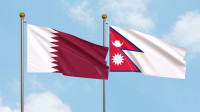National
Nepal and China to meet in Lhasa for secretary-level border and trade talks
The meeting of the joint mechanism scheduled for March 29-30 in the Tibet Autonomous Region is expected to facilitate bilateral trade.
Post Report
Senior officials from Nepal and China are meeting this week in Lhasa, the capital of the Tibet Autonomous Region, aiming to facilitate bilateral trade and commerce. This is the first meeting of the joint mechanism set up in August last year during the official visit of then foreign minister Narayan Khadka to Qingdao, China.
A statement issued after the visit had said the two foreign ministers decided to establish a joint mechanism for pandemic control in border ports. This was a time of obstruction in bilateral trade, export from Nepal and the movement of people.
The foreign ministers had then agreed to open Rasuwagadhi-Kerung and Tatopani-Zhangmu ports for two-way trade and Hilsa-Purang port for one-way trade subject to the taming of a Covid-19 wave in Tibet.
The upcoming two-day meeting will see discussions on issues related to trade, commerce, border infrastructure, trade facilitation, and exports of Nepali goods to China, said officials.
Nepali traders, politicians and officials have been raising the issues of obstruction in bilateral trade with China since the Covid outbreak at the end of 2019. Bilateral trade is taking place only via the Rasuwagadhi-Kerung border.
The primary agenda of the meeting is to facilitate bilateral trade, which has been obstructed for years, Narayan Prasad Regmi, spokesperson for the Ministry of Industry, Commerce and Supplies, said.
Madhu Marasini, secretary at the ministry, and Chen Yongqi, executive vice-chairman of the Tibet autonomous regional government who is also the Deputy Secretary of the District Party Committee, will lead the delegations from Nepal and China, respectively.
The March 29-30 meeting in Lhasa will be attended by officials from the Ministry of Foreign Affairs and the Ministry of Industry, Commerce and Supplies. Nepal’s bilateral trade, taking place mainly through the Tatopani-Zhangmu and Rasuwagadhi-Kerung border points, suffered due to China’s strict zero-Covid policy, which was lifted just months ago.
“We will discuss trade infrastructure at border points and issue of trade facilitation so that we can fully resume bilateral export and import,” Regmi said. Due to poor infrastructure on the Nepal side at both points, Nepali traders and importers are facing hassles.
China is Nepal’s second largest trading partner after India but the bilateral trade to the north has become largely one-sided for the past couple of years. In the year 2021, Nepal imported goods worth Rs235 billion from China and its export to the country was just US $8.41 million, according to the United Nations COMTRADE database on international trade.
“We will also discuss trade cooperation and border issues during the meeting,” Regmi added. In July last year, during the joint-secretary level bilateral consultative meeting, the two sides had agreed to resume two-way trade through Rasuwagadhi-Kerung port following Covid-19 health protocol and guidelines.
But due to China’s restrictive measures and poor infrastructure on the Nepal side, the Tatopani-Zhangmu trade point has yet to come into full operation. There were also talks for opening more trading points between Nepal and China.
The two sides in July last year decided to open the Hilsa-Purang border port for the transportation of goods and construction materials from China, aiming to support the livelihoods of people in the upper Himalayan region of Nepal. However, the decision is yet to be fully implemented given poor infrastructure on the Nepal side.
“Not long ago, the Gyirong-Rasuwa port resumed two-way cargo transfer and Pulan-Yari port resumed one-way cargo transfer,” Chinese Ambassador to Nepal Chen Song said in a recent interview with the Post. “The Chinese side will finish the construction of the Lizi port, and it is hoped that Nepal will complete the infrastructure on its side as soon as possible to create conditions for the early opening of Lizi-Nechung port.”




 7.12°C Kathmandu
7.12°C Kathmandu












%20(1).jpg&w=300&height=200)

